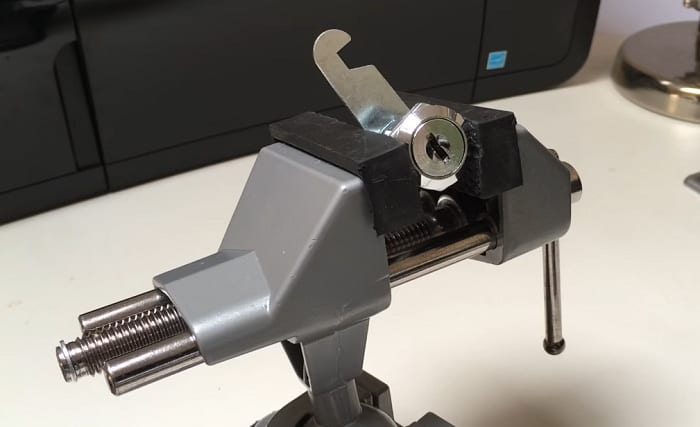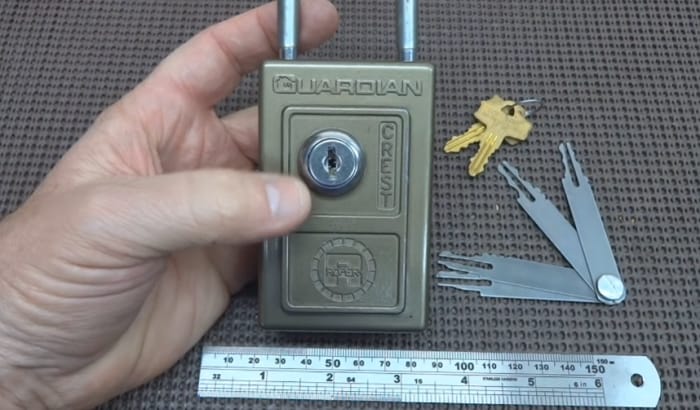Though they are not as well known as pin tumbler locks, you have probably seen and keyed in a wafer tumbler lock. They are commonly used in cabinets, desks, and there’s even a car wafer lock.
It operates the same way as its pin tumbler lock cousin. Still, one key difference of a wafer type, as the name suggests, is its flat wafers in the cylinder instead of pins. These wafers obstruct the keyway, and they can only be unlocked with a specific key.
It looks difficult to defeat, but there are tricks on how to pick a wafer lock.
Table of Contents
Step-by-Step to Pick a Wafer Lock
What to prepare
Ready your bottom of the keyway or Y-tensioner and pick set, as they will come in handy when defeating a wafer lock. Here are the types of picks you can use for the trick:
- Snake or Bogota rake
- Snowman or double ball pick
- Wafer lock pick
- Try-out keys or auto jigglers
Be reminded that bump keys and snap guns don’t work with wafer locks.
Picking a wafer lock comes easy for those with experience. There are two types of wafer locks: single-bitted and double-bitted. The former is easiest to pick with standard tools.
The first thing you need to do is to identify the type of lock you’re dealing with. Take note that keys of wafer and pin tumbler locks look the same, but you can’t use one for the other if you don’t want a wrong key stuck in the cylinder.
The point of picking this type of lock is to lift the wafers into the cylinder’s plug. When the obstructions (wafers) are gone, you can defeat its locking mechanism.
Step 1: Find the resistant wafer
For a single-wafer lock, you must find the wafer with the most resistance. Set it first using the bottom of the keyway tensioner.
Step 2: Set the other wafers
Afterward, use your preferred pick to set the other wafers one by one until you reach the end. When the wafers are not protruding, you can now rotate the cylinder to unlock it.
When you want to pick a double wafer lock, you must also set the most resistant wafer first. You can lift the upper or lower wafers first or do them alternately.
The snowman or double ball pick is your best bet when working with a double sided lock because it can set both sides at the same time.
The snake or Bogota rake, meanwhile, performs in the same way as a single-pin pick, only that you need to rattle it to raise the wafers into the plug — like trial and error, but success is guaranteed. With enough pressure, wafer lock rakes can do the trick.
Wafer lock jigglers work like rakes, too. These keys were made to defeat pin tumbler locks, and, as the name suggests, you just need to jiggle, wiggle, rattle, push, or pull to lift the wafers.
Using the trick mentioned above, you can also undo a padlock that has a wafer mechanism.
Helpful Tips
- Picking round locks such as a single-wafer lock is not just mere trial and error because you must know how to slowly navigate the protrusions of the cylinder until the end, tricking it that you’re inserting the master key, literally and figuratively.
- If you’re working with hardware that still has a wafer lock diagram, then you’ll have an easier time defeating the lock. If you have experience picking a pin tumbler lock, you can work with wafers in a jiffy because they are looser and less tolerant.
Are Wafer Locks Hard to Pick?
Wafer locks are not hard to pick because the standard tool can trick them. Some stores even offer wafer lock picks, making your life easier.
Can You Pick a Lock With a Paperclip?
It’s tricky, but you can unlock a wafer lock using a paperclip. As with a standard pick, your goal is to use the paperclip as a tool to push the wafers into the cylinder plug.
With a few twists and a push and pull here and there, you can hear that click that will unlock the wafer core lock. Patience is the key, after all.
Conclusion
When you lose your wafer lock key for your toolbox, cabinet, drawer, or even your car, don’t just use any random keys as they might cause more harm. Wafer locks are not reliable as they can be easily defeated, hence they are often used in enclosures and not as a main security fixture.
When learning how to pick a wafer lock, the best way to practice is with the standard pick or specialized ones like jigglers, rakes, or double-ball picks. A paperclip will work once you’ve mastered tricking this lock.

I am the last member to join Revolar and might be just the luckiest to work with dedicated people like Teddy and John. Our team has established a process where my only job is writing the best content to deliver incredible ideas and guides.




